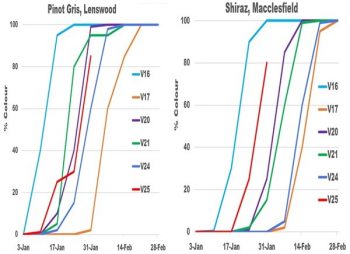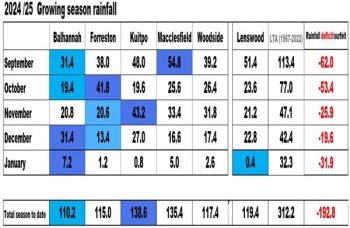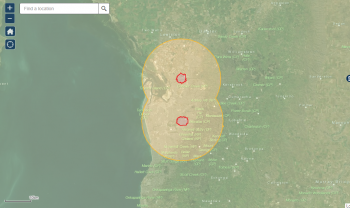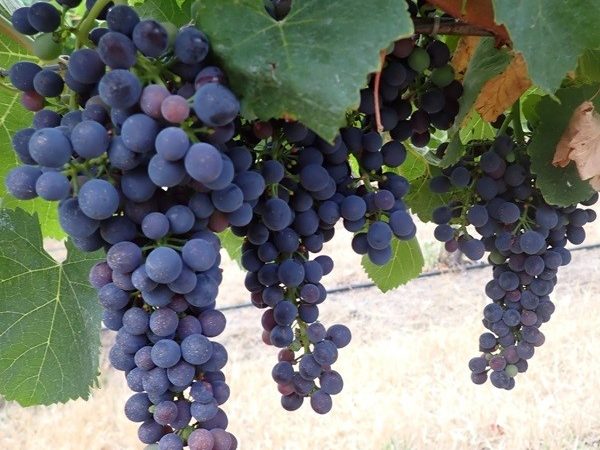I feel like I’m only just coming to terms with the fact that it’s 2025.
Meanwhile, in the vineyard, the grapes figured that out weeks ago and have been busy getting themselves ready to be harvested.
In fact, due to all this lovely summery/heatwave weather we’ve been having, Vintage 2025 is practically upon us.
Let’s take a look…
E-L Stage
Most advanced E-L 38 Berries harvest- ripe (for sparkling base wine)
Least advanced E-L 36 Berries with intermediate sugar levels.
Vintage 2025 – Adelaide Hills
The Adelaide Hills experienced a 4-day heatwave over the weekend/earlier in the week. This has encouraged the ripening of grapes across the region. It looks like some vineyards have even started harvesting early varieties. Checking in with Rob today, though, it seems like we could be a couple of a weeks away from sending any fruit into the winery. That’s mainly because the vineyards we get our fruit from are some of the highest (ie. coolest) in the Hills. I’ll keep you posted on those developments though.
The graph below (thanks to last week’s CropWatch report from Hamilton Viticulture) shows colour development of Pinot Gris in Lenswood and Shiraz in Macclesfield.

The rate of colour development in Pinot Gris still appears to be lagging in comparison to previous seasons. It’s currently two weeks behind Vintage 2016 (which is renowned as being a super early vintage) and one week ahead of Vintage 2024.
In contrast, Shiraz colour development has been rapid and is currently one week behind Vintage 2016 and is between 2-3 weeks ahead of Vintage 2024.
But, what does all this mean?
Well, ‘fast’ doesn’t always equal ‘better’.
As you know, the Adelaide Hills is classified at ‘Cool Climate’ and this “coolness” is crucial during the final stages of grape ripening. It’s what make our wines taste taste the way they do. The rise in heat and rapid ripening can start to affect the flavour profile of grapes.
It will be interesting to see what vintage variations (the difference between wines from one vintage to another) we’ll see in wines made for these grapes.
Whatever happens though, I know Rob has got it all under control!
And before I move on, here is another interesting table from the CropWatch report. It’s to do with rain (or the lack thereof). If you think it’s been a while since you’ve put your raincoat on, you’d be right…

This growing season currently sitting at an average of 192.8mm BEHIND the long term average.
Other regions…
I thought it might be of interest to have a quick look at what is happening in other regions around the state…
Being even warmer still, vineyards in the Barossa Valley and McLaren Vale wine regions are already harvesting fruit. This isn’t SUPER early for these regions but it’s still up the early end of the average timing for harvest.
If you cast your mind back you may remember that the Barossa Valley experienced severe frosts in September 2024. This lead to significant damage in many vineyards. Some wineries reported losses of up to 80% of their vines, with expectations of a 40% reduction in Shiraz and Chardonnay production for the 2025 vintage. Despite these challenges, growers have been optimistic about the quality of the remaining fruit, though yields are notably lower.
Again, I’m looking forward to seeing (or tasting!) the outcome of Vintage 2025 for these regions too.
Fruit fly
In late January 2025, a Queensland fruit fly outbreak was declared in Glynde, a northeastern suburb of Adelaide, after a resident reported finding maggots in home-grown peaches.
Eeek!
In response, the Department of Primary Industries and Regions SA (PIRSA) established a 1.5 km red outbreak zone around Glynde, with an additional 15 km yellow suspension area extending into parts of the Adelaide Hills wine region.
Residents within the red zone are required to keep home-grown fruit and vegetables on their properties and refrain from giving them away or selling them.
The anticipated end date for the Glynde outbreak is 23 April 2025, provided no further detections occur.
 Now, here is why that news is significant for the SA wine industry…
Now, here is why that news is significant for the SA wine industry…
- That 15 km yellow suspension area, which stretches into parts of the Adelaide Hills, could affect the movement of grapes and other produce. This could delay or complicate the transportation of harvested fruit to wineries.
- While grapevines themselves aren’t the primary target of fruit flies, the presence of the pest can disrupt vineyard operations. Wineries may need to increase biosecurity measures, including monitoring and pest control, which adds to operational costs and complexity during harvest (which is already costly and complex!).
- The outbreak could affect the export of wine and grapes, particularly if international markets impose stricter regulations or temporary bans on produce from affected areas.
- If not contained, the outbreak could spread to nearby regions like McLaren Vale or even the Barossa, further complicating harvest operations across South Australia.
Fingers crossed those pesky little critters will stay put and let us get on with making fabulous wine!!
